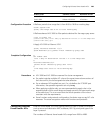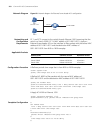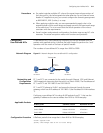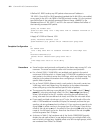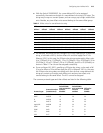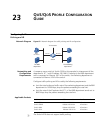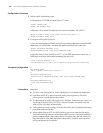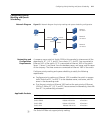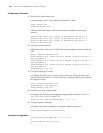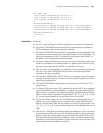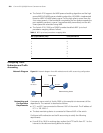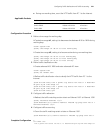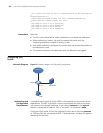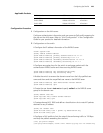216 CHAPTER 23: QOS/QOS PROFILE CONFIGURATION GUIDE
Configuration Procedure
1 Define traffic classification rules
# Create basic ACL 2000 and enter basic ACL view.
<3Com> system-view
[3Com] acl number 2000
# Define a rule to match the packets with source IP address 192.168.0.1.
[3Com-acl-basic-2000] rule permit source 192.168.0.1 0
[3Com-acl-basic-2000] quit
2 Configure traffic policing and LR
# Limit the total outbound traffic rate of the marketing department and the R&D
department to 16000 kbps, and drop the packets exceeding the rate limit.
[3Com] interface Ethernet 1/0/3
[3Com-Ethernet1/0/3] line-rate outbound 16000
# Limit the rate of the IP packets that PC 1 of the R&D department sends out to
8000 kbps, and drop the packets exceeding the rate limit.
[3Com] interface Ethernet 1/0/1
[3Com-Ethernet1/0/1] traffic-limit inbound ip-group 2000 8000 exceed drop
Complete Configuration #
acl number 2000
rule 0 permit source 192.168.0.1 0
#
interface Ethernet1/0/1
traffic-limit inbound ip-group 2000 rule 0 8000 exceed drop
#
interface Ethernet1/0/3
line-rate outbound 16000
#
Precautions Note that:
■ The ACL rules configured for traffic classification must be permit statements.
■ If packets match ACL rules of multiple traffic policing actions, the traffic
policing action issued the last takes effect.
■ The granularity of traffic policing and LR is 64 kbps. If the value you input is in
the range of N×64 to (N+1)×64 (N is a natural number), the switch sets the
value to (N+1)×64 kbps automatically.
■ Traffic policing or rate limiting just limits the traffic rate of payloads (excluding
preambles and interframes).
■ When referencing an ACL for traffic policing, you must note that the action
that traffic policing takes on conforming traffic is permit. If a packet matches a
permit statement and a deny statement at the same time, the one issued the
last takes effect. If the deny statement takes effect, no traffic policing action
will be performed on the packet.




